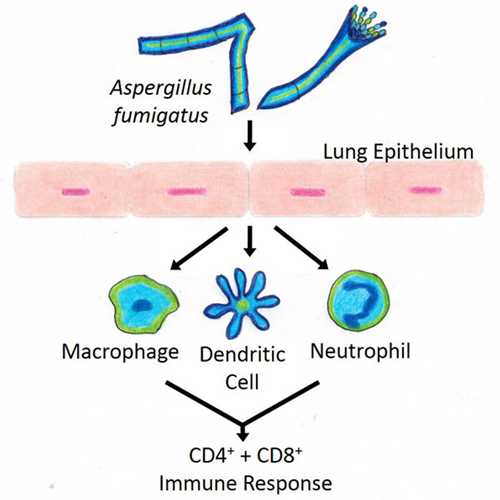Anti-Aspergillus fumigatus [8A1] Antibody
This hybridoma line constitutively produces a mouse anti-Aspergillus fumigatus monoclonal antibody (clone 8A1) specific to the conidium and basal region.
Highlights:
- Reacts with Aspergillus fumigatus
- Suitable for ELISA and Immunofluorescence applications
Recombinant versions available from our sister company, Absolute Antibody:
- Manufactured using Absolute Antibody’s Recombinant Platform with variable regions (i.e., specificity) from the hybridoma 8A1.
Aspergillus fumigatus is a widespread saprobe that breaks down organic material in soil. The conidia of this fungus are ubiquitous in the atmosphere and commonly inhaled. In healthy individuals, A. fumigatus can cause allergic reactions or localized infections. In the immunocompromised, however, it can cause invasive aspergillosis, an increasingly frequent and often fatal diease.
From the laboratory of Michelle Momany, PhD, University of Georgia.
This hybridoma line constitutively produces a mouse anti-Aspergillus fumigatus monoclonal antibody (clone 8A1) specific to the conidium and basal region.
Highlights:
- Reacts with Aspergillus fumigatus
- Suitable for ELISA and Immunofluorescence applications
Recombinant versions available from our sister company, Absolute Antibody:
- Manufactured using Absolute Antibody’s Recombinant Platform with variable regions (i.e., specificity) from the hybridoma 8A1.
Aspergillus fumigatus is a widespread saprobe that breaks down organic material in soil. The conidia of this fungus are ubiquitous in the atmosphere and commonly inhaled. In healthy individuals, A. fumigatus can cause allergic reactions or localized infections. In the immunocompromised, however, it can cause invasive aspergillosis, an increasingly frequent and often fatal diease.
From the laboratory of Michelle Momany, PhD, University of Georgia.
| Catalog Number | Product | DataSheet | Size | AVAILABILITY | Price | Qty |
|---|---|---|---|---|---|---|
|
EGA107
|
Anti-Aspergillus fumigatus [8A1] Hybridoma, 1 vial
|
1 vial | In stock |
Regular Price:$1,087.00
On Sale:
|
|
|
|
EGA122
|
Anti-Aspergillus fumigatus [8A1] Antibody
|
5mL (supernatant) | In stock |
Regular Price:$319.00
On Sale:
|
|
|
|
Kf-Ab01466-1.1
|
Recombinant Anti-Aspergillus fumigatus cell walls [8A1], Mouse, IgG1
|
200ug | In stock |
Regular Price:$484.00
On Sale:
|
|
|
|
Kf-Ab01466-23.0
|
Recombinant Anti-Aspergillus fumigatus cell walls [8A1], Rabbit, IgG
|
200ug | In stock |
Regular Price:$484.00
On Sale:
|
|
| Product Type: | Antibody |
| Name: | Aspergillus fumigatus [8A1] Antibody |
| Cell Type: | Hybridoma cell line |
| Antigen: | A. fumigatus cell wall |
| Isotype: |
EGA122: IgG Recombinant versions: see product name |
| Clonality: | Monoclonal |
| Clone Name: | 8A1 |
| Reactivity: | Aspergillus fumigatus |
| Immunogen: | A. fumigatus237 isolated cell walls |
| Growth Conditions: | IMDM + 20% FBS + 1% Pen/Strep |
| Cryopreservation: | Resuspend cells in 90% MDM, 10% DMSO. Store vials at -80C for 24-48 hrs at -70 before transfer to liquid nitrogen. |
| Species Immunized: | Mouse |
| Epitope: | Conidium and basal, no septa |
| Buffer: |
EGA122: Cell culture supernatant Recombinant versions: PBS with 0.02% Proclin 300 |
| Tested Applications: | ELISA , IF 1:10 |
| Storage: | -80C |
| Shipped: | Dry ice |
A. fumigatus mAbs show distinct localization patterns

A. fumigatus 237 was grown for 1214 h, fixed, incubated with primary mAb, followed by FITC-conjugated anti-mouse secondary antibody, Calcofluor White to label chitin and Hoechst 33258 to label nuclei. Primary antibodies: mAb1E2 (a), mAb8A1 (b) and mAb19H1 (c). Left column, FITC; right column, chitinous cell wall and nuclei. Arrows mark conidia; arrowheads mark septa; the double arrowhead marks a newly formed branch from main hypha.
Adapted from: Momany, M., et al. (2004) Microbiology 150, 3261-8.
- Ste-Marie L, Sénéchal S, Boushira M, Garzon S, Strykowski H, Pedneault L, de Repentigny L. Production and characterization of monoclonal antibodies to cell wall antigens of Aspergillus fumigatus. Infect Immun. 1990 Jul;58(7):2105-14.
- Momany M, Lindsey R, Hill TW, Richardson EA, Momany C, Pedreira M, Guest GM, Fisher JF, Hessler RB, Roberts KA. The Aspergillus fumigatus cell wall is organized in domains that are remodelled during polarity establishment. Microbiology. 2004 Oct;150(Pt 10):3261-8.
If you publish research with this product, please let us know so we can cite your paper.

![Anti-Aspergillus fumigatus [8A1] Antibody Anti-Aspergillus fumigatus [8A1] Hybridoma](https://www.kerafast.com/MediaStorage/Product/Images/Medium/4817_2001202001290348160.jpg)

